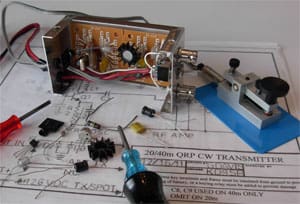To the editor: The recent section on communications (Issue #224, March/April 2015) contains numerous mentions of ham radio operations. I am compelled to write about my experience with low-power ham continuous wave (CW) transmitters. CW is another way of saying Morse code.
A few years ago, I developed a 1.3-watt output, solar/battery-powered pocket-size sailboat transmitter. The transmitter operates on the CW portion of the 20-meter ham band, at the frequency favored by low-powered operators — 14.06 MHz. The transmitter has a loop-through connection for the receiver antenna, weighs 5.5 ounces and has diode protection for high standing wave ratio (SWR). It can also be built for 40 meters, with approximately a 2.25-W output. The inductors for the RF oscillator, RF amp and PI output filter are off-the-shelf miniature parts from Mouser Electronics. No coils have to be wound, and no tuning controls are used. The on/off switch also switches the antenna from transmit to receive. A No. 47 miniature lamp is used as a dummy antenna load during initial testing. For power it uses a 4- to 7.5-amp-hour, 12-volt sealed lead acid battery.
The transmitter circuit is deceptively simple. Any General Class or higher licensed ham with some soldering and building experience could construct it as a weekend project.
I use a Yaesu VR-500 pocket communications receiver or a similar Kenwood TH-F6A for receiving. The 20-meter antenna used is the same basic antenna that I described in an article in Ocean Navigator (Issue #139, “Emergency HF antenna”). Instead of a commercial balun, a common mode choke coil is now used at the antenna feed point (six turns of 50-ohm coax, 7 inches in diameter). The antenna is held aloft and to windward by a spare halyard.
In 2013, a sailing friend received his General Class ham license after only four weeks of study. In 2014, he sailed his 28-foot sailboat to Georgetown, Bahamas, with an identical transmitter on 14.06 MHz, which I built for him. During his six-week voyage, we maintained Morse code contact almost daily. The average contact distance was about 1,250 statute miles. As a licensed ham operator, you are allowed by FCC regulations to build your own transmitter. It does not have to be FCC type accepted, but should meet certain harmonic attenuation requirements. The signal from the 1.3-W transmitter was weak, of course. I received it here in Indiana on an ICOM 735 with the 10-dB preamp switched on. However, the low-power CW signal was heard and copied almost every day.
In an emergency this might be an advantage, as many CW low-power ham operators regularly monitor this frequency. Recently I have added a second crystal frequency of 14.05 MHz, which is less active, to his transmitter for his next voyage.
My two-transistor transmitter design was inspired by Thor Heyerdahl’s 1947 Kon-Tiki balsa-raft voyage across the Pacific from Peru to Polynesia. On board the balsa-raft was a custom-built 20/40 meter two-tube CW ham transmitter, with about a 6-W output.
—Gary Davis (KD9SB) is a retired broadcast radio engineer, sailor and ham operator in Columbus, Indiana.

